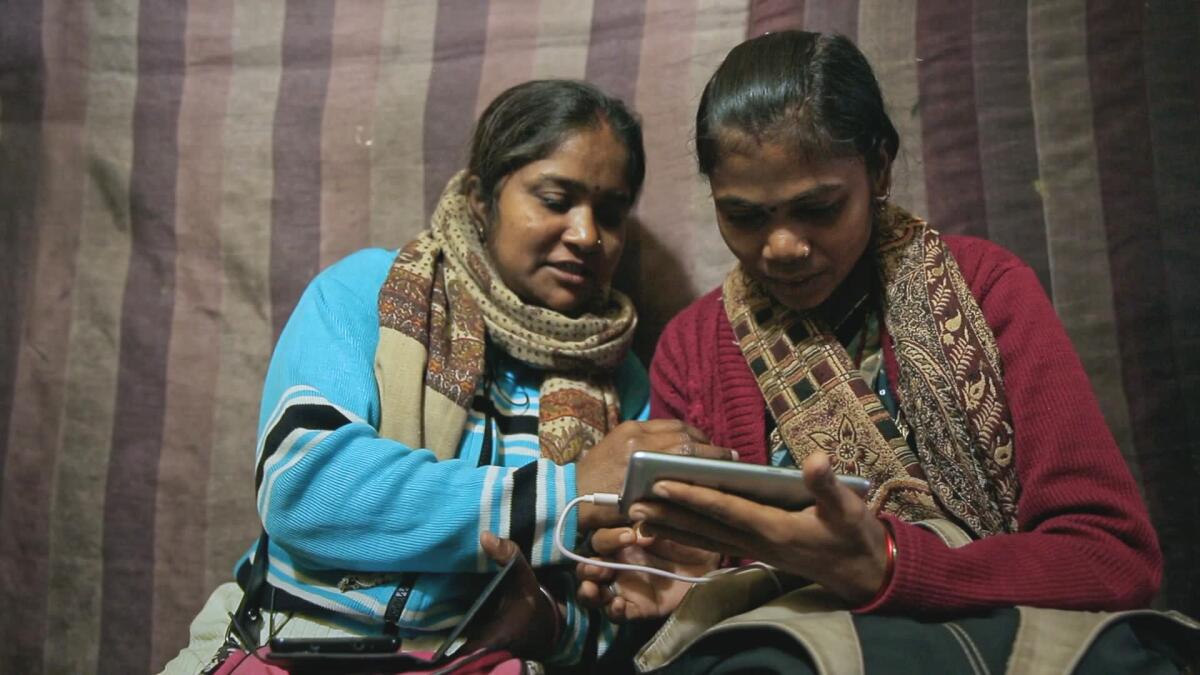Documentary centers on India’s all-female news team walking into danger, earning respect

- Share via
When Rintu Thomas and Sushmit Ghosh were pitching the idea for “Writing With Fire,” the filmmakers discovered they would have to expand on their description of the project. The documentary tracks the heroic efforts of an all-female news operation — the only one of its kind in India — as it transitions from print to digital journalism. But there are other factors at play, which make the narrative more complex and dramatic than might be implied.
The women are Dalits, the so-called “untouchables,” a category excluded from India’s caste system, legally banned in 1948 yet still in practice. They live in the rural north of Uttar Pradesh, India’s most populous province and source of an extraordinary volume of reports of violence against women. Against all odds, the women have published the Khabar Lahariya newspaper since 2002. Now the odds increase, as they start a YouTube channel with reporters “most of whom had never touched a smartphone,” Thomas said. Suddenly, they bring vivid global exposure to a part of the world ignored by other media.
“We had to articulate how the film was far more than a story about journalism,” said Thomas, who spoke during a Zoom conversation from India a couple of days after “Writing With Fire” was nominated for an Academy Award for documentary feature. The Music Box Films release, which also won audience and special jury honors at the 2021 Sundance Film Festival, begins streaming March 1.
“Usually, in a journalism film there is a case that becomes the heart of the story. Here, the whole way the story is structured is so different. Sure, they’re journalists. But they’re also feisty women first, and that’s what we wanted to put at the center of the film.”
The pair, who met in film school and later wed, focus on the endeavors of three women, whose personal stories alternate with the tough pieces they report:
Meera Devi is the senior figure who guides novice staffers as they learn the profession and displays formidable reporting skills in tense situations.
Suneeta Prajapati, as Thomas described her, is “so ambitious, the youngest in the room, and completely a foil to Meera,” she said. “She always likes challenging authority and had a lot of energy, but Meera needed to hone that energy.”
Shyamkali Devi, another aspiring reporter, offers a third perspective: Full of nervous energy, she is uncertain what to do when she’s handed a smartphone. But, as Thomas observed, “still waters run deep.” The film follows her up a steep professional learning curve.
To shadow the women as they ventured into villages, police stations and private homes, the filmmakers had to minimize their gear. “We had imagined we would shoot this film in 4K,” said Ghosh, who handled camera duties along with a co-cinematographer, Karan Thapliyal. They immediately realized that they would be shooting in areas with no electricity, where average temperatures exceeded 100 degrees and, because they were in India’s mining belt, laden with dust.
“Also, just the brutal physicality of being a journalist and traveling in these parts,” he said, meant they had to shoot with DSLR cameras. A handheld approach proved strategic, as the camera adopts its subjects’ point of view. “Both Karan and I are fairly tall men, while the women were short. When you look at the world from their perspective, everyone looks much taller. You see these male figures around them. We wanted to also give the audience a sense of the visual patriarchy as well.”
Traditionally, journalists who were male and from a higher caste would not set foot in the villages. “A lot of these communities had never seen a film crew,” Thomas said. Whether investigating incidents of illegal mining, cases of terrible violence or the charged buildup to the 2019 election, the women navigate unstable terrain with persistence and grace. They not only achieve results, but they also win respect.
“What we observed early on was the absolute trust these communities had in these women,” Thomas said. “Most of the time, they were just waiting for someone to show up and bear witness to their story.”
Although the women plunged into situations that were dangerously charged, even the simplest daily endeavors made them subject to unwanted attention from intently watchful men. “There aren’t many women doing professional, on-the-go jobs,” Thomas said. “There is never a moment of being at ease.”
The filmmakers, who accompanied their subjects into “spaces of deep trauma” as they reported on rape and murder cases, also looked to them for their own cues. There was acute wariness. “As a woman, I felt very, very uncomfortable at these big rallies, these big crowds of men, young boys,” Thomas recalled. “Anything could become volatile at any time.
“My guiding lights were Suneeta and Meera. They somehow had cracked the code. They knew which part of the crowd to go to, where not to enter, where to get your final shot from and when the story’s done — and get out. It’s a kind of skill I never witnessed.”
More to Read
From the Oscars to the Emmys.
Get the Envelope newsletter for exclusive awards season coverage, behind-the-scenes stories from the Envelope podcast and columnist Glenn Whipp’s must-read analysis.
You may occasionally receive promotional content from the Los Angeles Times.







